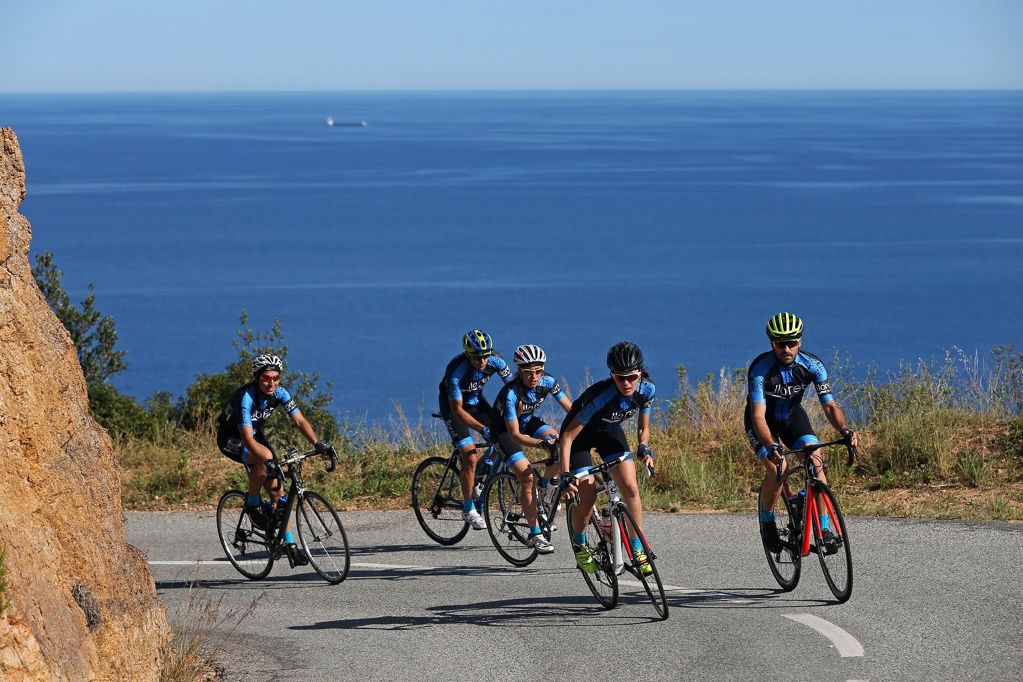
Lloret de Mar - Calonge - La Bisbal - Santa Pellaia - Sant Grau - Lloret de Mar
Lloret de Mar - Calonge - La Bisbal - Santa Pellaia - Sant Grau - Lloret de Mar
 Distance:
132 km
Distance:
132 km
 Elevation gain:
1.850 m
Elevation gain:
1.850 m
 Max. Elevation:
435 m
Max. Elevation:
435 m
Water points
- Tossa de Mar
- Sant Feliu de Guíxols
- Platja d’Aro
- Sant Antoni de Calonge
- Calonge
- La Bisbal d’Empordà
- Cruïlles
- Cassà de la Selva
- Llagostera
- Tossa de Mar

|
MOUNTAIN PASSES |
CATEGORY |
DISTANCE |
ELEV. CHANGE |
AV. GRADE % |
MAX. GRADE % | ||
|
Coll de Ganga |
3 |
4 KM |
2,48 MI |
340 M |
1115 FT |
4% |
6,2% |
|
Coll de Santa Pellaia |
2 |
6 KM |
3,72 MI |
400 M |
1342 FT |
4% |
7% |
|
Alt de Sant Grau |
3 |
9 KM |
5,59 MI |
347 M |
1138 FT |
4% |
7% |
|
SECTIONS WITH TRAFFIC DENSITY / ROAD SURFACE DEFECTS |
HIGH DENSITY |
MEDIUM DENSITY |
LOW DENSITY |
|
Lloret - S. Feliu de Guíxols |

Secondary road |
||
|
S. Feliu Guíxols - Calonge |

Dense urban and inter-urban section |
||
|
Calonge - Cassà Selva |

Secondary road |
||
|
Cassà Selva- Llagostera |

Straight section with wide hard shoulder |
||
|
Llagostera -Lloret |

Secondary road |
Departing from the Central Tourist Office of Lloret de Mar located in Carrer de les Alegries, 3, we follow the East exit from the city, crossing Lloret, and take the GI-682 road in the direction of Tossa de Mar.
We cross Tossa de Mar and continue along the same road in the direction of Sant Feliu de Guíxols. This is the start point of one of the best coastal roads that can be ridden on anywhere in Europe. It offers stunning sea views with the towering cliffs and spectacular coves of the Costa Brava, along with a series of climbs and descents that will warm up your legs if you ride with intensity.
We reach Sant Feliu de Guíxols and take the C-253 road to Sant Antoni de Calonge and Calonge. We take the GI-660 road in the direction of La Bisbal d’Empordà. Here we begin a gentle climb up to the Ganga Pass along a quiet, winding road. Once we reach the top of the pass a pleasant descent takes us down to the town of La Bisbal d’Empordà.
At La Bisbal d’Empordà we take the GI-664 road in the direction of Cruïlles, beginning a stretch of serious pedalling. We’re in the Gavarres Massif, embarking on one of the favourite climbs of local professional cyclists: the Santa Pellaia Pass, an enjoyable and progressive ascent. Once we reach the top a rapid descent takes us down to Cassà de la Selva.
At Cassà de la Selva we take the C-65 road in the direction of Llagostera, a fantastic 4 km straight stretch ideal for high speeds.
Once we reach Llagostera we take the GIP-6821 road, where the Alt de Sant Grau Pass begins, at Puig de Cadiretes, a mountain in the heart of the Ardenya Massif. This is an enjoyable 9 km climb requiring intense effort.
Leaving Sant Grau behind, we begin a rapid descent on which to enjoy some more breathtaking views of the Costa Brava. This descent takes us back to the GI-628 road we started on. We head in the direction of Tossa de Mar and then ride on to Lloret de Mar, the start and end point of the route.
It’s important to bear in mind that during the high summer season the GI-682 road becomes the main access road to beaches, with dense traffic, and should not be considered a secondary road at this time of year. You should avoid weekends from the second fortnight of June to the second fortnight of September, and it’s best to avoid the entire month of August.
Points of interest
Tossa de Mar: ancient fishing village, easily recognisable thanks to its silhouette featuring the tower of the mediaeval walled enclosure. A town with an aura of glamour ever since Pandora and the Flying Dutchman was filmed there in 1951, starring Ava Gardner, James Mason and the bullfighter Mario Cabré.
Sant Feliu de Guíxols: a tourist town with a unique architectural legacy, including a fortified Benedictine monastery next to the sea. Porta Ferrada, one of the longest established international summer festivals of music, theatre and dance on the Costa Brava, is held in Sant Feliu.
La Bisbal d’Empordà: Artisanal ceramics are of great importance to this inland town in the Empordà region, bringing it to life and adding colour to its streets.
Gavarres Massif: the landscape of this inland massif is characterised by dense holm oak forests and scattered farmhouses. With gentle hills and fantastic elevation changes, this area contains some of the favourite climbs of local professional cyclists: Els Àngels, Santa Pellaia, Romanyà, etc.
Santa Pellaia: this Romanesque chapel crowns the pass, standing in a commanding position on the crest of the Gavarres Massif.
Sant Grau d’Ardenya: large church in the neo-Romanesque style, attached to a building with the appearance of a traditional Catalan farmhouse. The road to the chapel offers one of the area’s most stunning views of the Mediterranean Sea.
Ardenya Massif: massif that falls away steeply, forming cliffs and coves along the coast between Sant Feliu de Guíxols and Tossa de Mar. This impressive, wild landscape inspired the local journalist and poet Ferran Agulló to christen this stretch of coastline the “Costa Brava”.